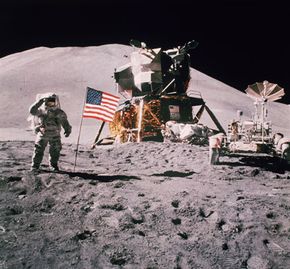Returning to the Moon
Apollo 11 was the first U.S. mission to land on the moon, but it wasn't the last. Here are rundowns of the other six moon missions:
Apollo 12
- Launch date: Nov. 14, 1969
- Crew: Charles Conrad Jr. (Commander), Richard F. Gordon (Command Module Pilot), Alan L. Bean (Lunar Module Pilot)
- Landing site: Sea of Storms
- Mission: recovered pieces from the Surveyor 3 to help scientists study the effects of time on equipment in the moon's environment and proved precise lunar landings were possible.
Apollo 13
- Launch date: April 11, 1970
- Crew: James A. Lovell, Jr. (Commander), John L. Swigert Jr. (Command Module Pilot), Fred W. Haise Jr. (Lunar Module Pilot)
- Mission: The crew aborted after an oxygen tank in the Service Module exploded and ruptured mid-flight. The crew moved into the Lunar Module and safely navigated back to Earth.
Apollo 14
- Launch date: Jan. 31, 1971
- Crew: Alan B. Shepard Jr. (Commander), Stuart A. Roosa (Command Module Pilot), Edgar D. Mitchell (Lunar Module Pilot)
- Landing site: Fra Mauro region
- Mission: Shepard and Mitchell climbed the side of Cone Crater to see how easily they could move in their bulky space suits. Shepard hit two golf balls.
Apollo 15
- Launch date: July 26, 1971
- Crew: David R. Scott (Commander), Alfred J. Worden (Command Module Pilot), James B. Irwin (Lunar Module Pilot)
- Landing site: Hadley Rille/Apennines region
- Mission: Astronauts used the Lunar Roving Vehicle to explore the surface of the moon. Scott demonstrated that a hammer and feather fell at the same rate. The crew left behind a plaque commemorating the 14 American and Soviet astronauts who had died since the space program's start.
Apollo 16
- Launch date: April 16, 1972
- Crew: John W. Young (Commander), Thomas K. Mattingly II (Command Module Pilot), Charles M. Duke Jr. (Lunar Module Pilot)
- Landing site: Descartes region
- Mission: Covered nearly 17 miles in the Lunar Roving Vehicle. The crew collected rock and soil samples and used an ultraviolet camera and spectrograph to capture the first astronomical measurements from the moon's surface.
Apollo 17
- Launch date: Dec. 7, 1972
- Crew: Eugene A. Cernan (Commander), Ronald E. Evans (Command Module Pilot), Harrison H. Schmitt (Lunar Module Pilot and scientist)
- Landing site: Taurus-Littrow region
- Mission: Covered more than 60 miles (97 kilometers) in the Lunar Roving Vehicle and studied volcanic vents to learn about the moon's origins. The crew left a plaque reading, "Here man completed his first exploration of the moon, December 1972 A.D. May the spirit of peace in which he came be reflected in the lives of all mankind."
Before taking his final step off of the moon, Gene Cernan uttered the last words to be spoken on its surface: "We leave as we came and, God willing, as we shall return, with peace and hope for all mankind."
Advertisement
After six moon landings, American scientists had a greater understanding of our nearest celestial neighbor. They determined the age of the moon -- about 4.5 billion years -- and came up with a theory for how it formed.
After the Apollo program ended in 1972, NASA did not send any more astronauts to the moon. With the country mired down in the Vietnam War, the once enraptured public was beginning to lose interest in the space missions. In the next section, we'll learn about the future of lunar exploration.
